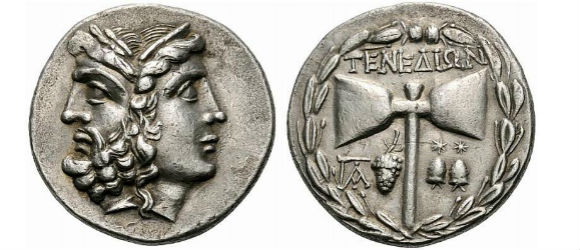The area south and west of the Sea of Marmara and the Dardanelles is the general district of Mysia with Pergamon (Bergama) and Cyzicus (Erdek) the main cities. Mysians are among those named by Homer as allies of Troy.
Mysia was a region in the northwest of ancient Asia Minor or Anatolia (part of modern Turkey). It was located on the south coast of the Sea of Marmara. It was bounded by Bithynia on the east, Phrygia on the southeast, Lydia on the south, Aeolis on the southwest, Troad on the west and by the Propontis on the north. In ancient times it was inhabited by the Mysians, Phrygians, Aeolian Greeks, and other groups.
A minor episode in the Trojan War cycle in Greek mythology has the Greek fleet land at Mysia, mistaking it for Troy. Achilles wounds their king, Telephus, after he slays a Greek; Telephus later pleads with Achilles to heal the wound. This coastal region ruled by Telephus is alternatively named Teuthrania in Greek mythology, and was previously ruled by a King Teuthras.
In the Iliad, Homer represents the Mysians as allies of Troy, with the Mysian forces led by Ennomus (a prophet) and Chromius, sons of Arsinous. Homeric Mysia appears to have been much smaller in extent than historical Mysia, and did not extend north to the Hellespont or the Propontis. Homer does not mention any cities or landmarks in Mysia, and it is not clear exactly where Homeric Mysia was situated, although it was probably located somewhere between the Troad (to the northwest of Mysia) and Lydia/Maeonia (to its south).
There are a number of Mysian inscriptions in a dialect of the Phrygian language, in a variant of the Phrygian alphabet. There are also a small number of references to a Lutescan language indigenous to Mysia in Aeolic Greek sources.
The precise limits of Mysia are difficult to assign. The Phrygian frontier was fluctuating, while in the northwest the Troad was only sometimes included in Mysia. The northern portion was known as Lesser Phrygia or Phrygia Minor (Ancient Greek: μικρὰ Φρυγία), while the southern was called Major or Pergamene. Mysia was in later times also known as Phrygia Hellespontica (Ἑλλησποντιακὴ Φρυγία, “Hellespontine Phrygia”) or Phrygia Epictetus (ἐπίκτητος Φρυγία, “acquired Phrygia”), so named by the Attalids when they annexed the region to the Kingdom of Pergamon.
The chief physical features of Mysia are the two mountains Mount Olympus at (7600 ft) in the north and Mount Temnus in the south, which for some distance separates Mysia from Lydia and is afterwards prolonged through Mysia to the neighbourhood of the Gulf of Adramyttium. The major rivers in the northern part of the province are the Macestus and its tributary the Rhyndacus, both of which rise in Phrygia and, after diverging widely through Mysia, unite their waters below the lake of Apolloniatis about 15 miles (24 km) from the Propontis. The Caïcus in the south rises in Temnus, and from thence flows westward to the Aegean Sea, passing within a few miles of Pergamon. In the northern portion of the province are two considerable lakes, Artynia or Apolloniatis (Abulliont Geul) and Aphnitis (Maniyas Geul), which discharge their waters into the Macestus from the east and west respectively.
The most important cities were Pergamon in the valley of the Caïcus, and Cyzicus on the Propontis. The whole sea-coast was studded with Greek towns, several of which were places of considerable importance; thus the northern portion included Parium, Lampsacus and Abydos, and the southern Assos, Adramyttium. Further south, on the Eleatic Gulf, were Elaea, Myrina and Cyme.
A minor episode in the Trojan War cycle in Greek mythology has the Greek fleet land at Mysia, mistaking it for Troy. Achilles wounds their king, Telephus, after he slays a Greek; Telephus later pleads with Achilles to heal the wound. This coastal region ruled by Telephus is alternatively named Teuthrania in Greek mythology, and was previously ruled by a King Teuthras. In the Iliad, Homer represents the Mysians as allies of Troy, with the Mysian forces led by Ennomus (a prophet) and Chromius, sons of Arsinous. Homeric Mysia appears to have been much smaller in extent than historical Mysia, and did not extend north to the Hellespont or the Propontis. Homer does not mention any cities or landmarks in Mysia, and it is not clear exactly where Homeric Mysia was situated, although it was probably located somewhere between the Troad (to the northwest of Mysia) and Lydia/Maeonia (to its south).
Mysia,
